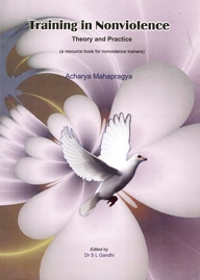Dharma (religion) should be instrumental in bringing about our emotional and qualitative growth. The fruit of dharma is compassion (karuna). Let us awaken our consciousness of compassion and equanimity towards all living beings. Bereft of compassion and sensitivity, a question mark arises over our religiousness. Dharma should lead to the transformation of our consciousness and improvement in human relationship. If a person is devoid of compassion, the principle of human rights is of no avail. It is imperative that religious leaders, administrators and chiefs are imbued with compassion and sympathy. These qualities should also be reflected in their behaviour. If there is compassion in society, it will remain healthy. Dharma is being defiled and degraded in many communities on account of their contradictory norms of conduct and social practices. Where there is cruelty, we cannot build a healthy society. In order to understand the true nature of dharma, one will have to purge one’s mind of a feeling of cruelty.
Today man’s greed for wealth has increased to such an extent that it will be better for us to call him arthapurusha (one who hankers after wealth) instead of dharamapurush (religious person). Material objects are necessary for a person’s living but it is not right to develop excessive attachment towards them. Owning a material object is not parigraha (possessiveness) but it is one’s covetousness for it that can be described as parigraha. It is of two kinds - dravya parigraha (material possession) and bhava parigraha (deep attachment to a material possession). In other words a feeling of attachment for a material object or what we call wealth, pieces of land, houses, cattle etc. is bhav parigraha. It is this form of parigraha that is at the root of violence. Cruelty is too associated with this sort of possessiveness.
Human rights can be preserved only if human relations improve. The problems that we see in the world today emanate from an unjust and unfair economic system. For the solution of these problems, it is imperative that we effect changes and improvements in our economic coordination.
The balance between the four pursuits - dharma (righteousness), artha (wealth), kama (desire) and moksa (liberation) - has been upset. The whole world is now dominated by wealth and desire. To restore this balance it is necessary that we try to understand the nature of dharma. Let us also reflect on the question as to what dharma is giving us. This trend of thinking can change the course of our life.
The fruit of dharma is inner happiness. A person may follow the path of dharma but if he is not intrinsically happy, we can conclude that dharma has not become an integral part of his or her life. Joy and happiness are the two different states of human mind. Joy and sorrow go together. Happiness is different from both of them. There is neither joy nor sorrow in the state of one’s mind. One doesn’t feel exhilarated when one meets favourable circumstances, nor does one feel sad when one finds oneself in adverse circumstances. Inner happiness is the purest state of consciousness. Joy and sorrow are not connected with the incident. They are associated with one’s emotions. The cycle of joy and sorrow has been going on incessantly. This process disrupts the balance between human mind and human health.
Inner happiness is an experiment in spirituality. Let us try to keep our soul happy. In a state of inner happiness, a person thinks positively and evinces concern for the welfare of others. His behaviour and conduct appear radically different. In the words of Maharishi Patanjali happiness is what we experience in a state of thoughtlessness. A person is able to commune with the soul when his mind stops wavering and is emptied of thoughts. But the mind is so fickle and restless that the waves of thought continue to arise in it ceaselessly. More than thirty-three vibrations of thought occur in a second.
A person who has learnt to stay in this state of emptiness even for five minutes is able to seek answers to his questions. It is a state of absolute emptiness: no memory, no thinking, no imagination. It is a state beyond the three stages of time - past, present and future. He who has learnt to stay in this state of mind achieves inner happiness. His sorrows come to an end. He who is free from attachment and hatred and only uses his senses dispassionately experiences true happiness. There are only two components that obstruct a person’s inner happiness: attachment and hatred. What is expected is that we learn how to remain naturally happy. All spiritual activities lead to true happiness. Come! Let us follow the path of spirituality and try to exercise restraint on our passions of attachment and hatred in order to be really happy.
samyag-darsana-jnana-caritrani moksamargah
The enlightened world-view, enlightened knowledge and enlightened conduct are the path to liberation
– Tattvarth Sutra
 Acharya Mahaprajna
Acharya Mahaprajna

